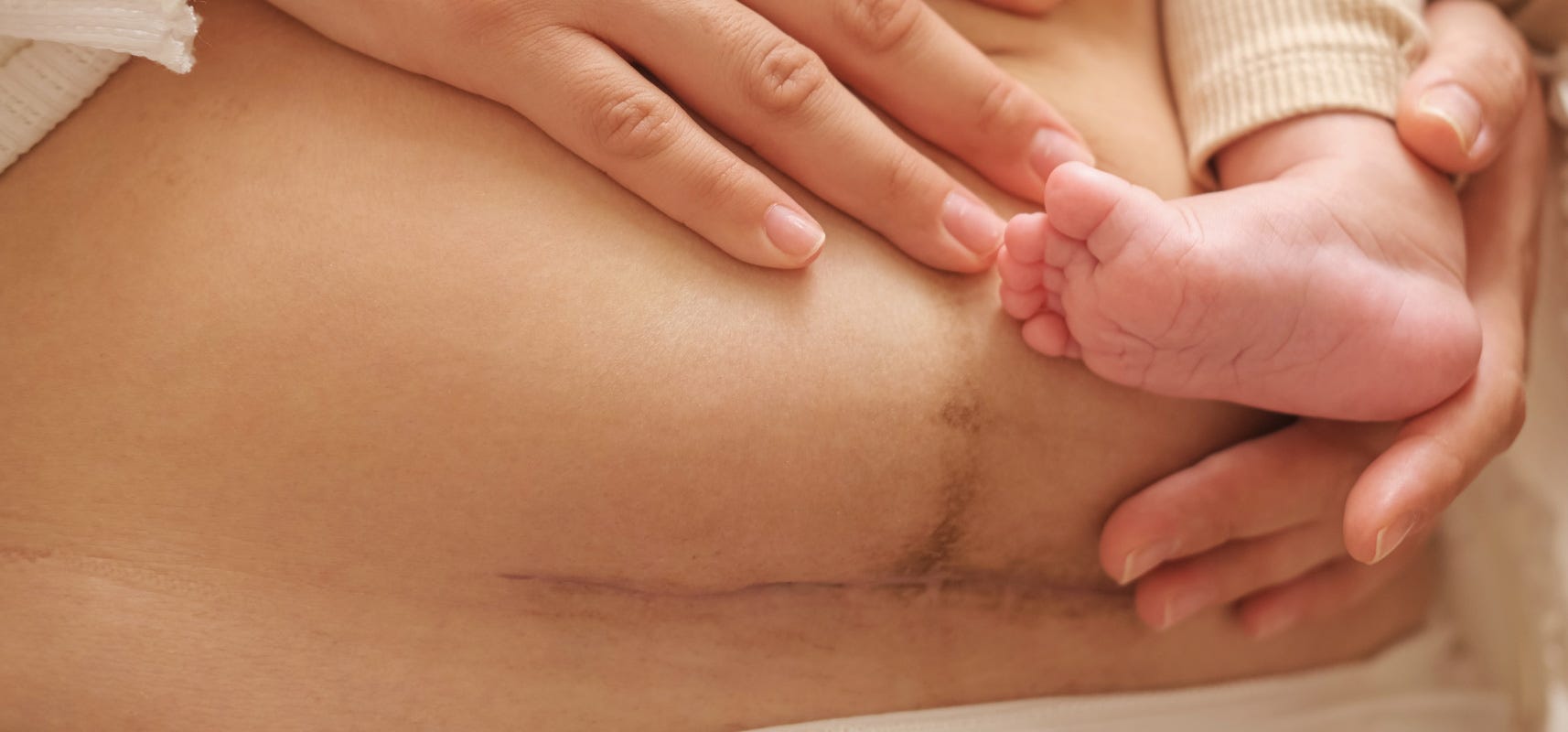Preparing for a cesarean section, mama? You're in the right place! While learning that you need a C-section might not have been part of your original birth plan, having time to prepare can help you feel more confident and in control of your birth experience. In this comprehensive guide, we'll walk you through everything you need to know about preparing for your planned C-section.
Remember, a C-sectionis a major surgery. Whether this is your first C-section or you've been through this before, preparation is key to a smooth experience and recovery. And while they aren’t completely without risk, a C-section is a common procedure experienced by 1 in 3 birthing moms in the U.S.
As you begin preparing for a C-section, it's important to understand that good preparation involves several key areas: medical readiness, practical planning, and emotional preparation. We'll cover all these aspects to help you feel confident and prepared for your baby's arrival.
IN THIS ARTICLE:
Understanding Your Planned C-Section
About C-Sections and Blood Clots
Physical Preparation for Your Scheduled C-Section
C-Section Hospital Bag Essentials
Preparing Your Home for Your C-Section Recovery
Meal Prep and Securing Older Childcare
Understanding Your Planned C-Section


There are several reasons why your healthcare provider might recommend a planned C-section instead of a vaginal birth. These can include:
-
Baby's position (such as breech presentation)
-
Multiple pregnancies
-
Previous C-sections
-
Placenta location
-
Medical conditions affecting you or your baby
-
Structural concerns about your pelvis or uterus
Understanding the specific reason for your C-section can help you feel more confident and better prepared for the procedure.
Your healthcare team will have several conversations with you in the weeks leading up to your scheduled C-section. These discussions will cover important topics like anesthesia options, pre-operative instructions, the potential for a gentle C-section approach, how soon you and your baby can experience skin-to-skin contact, and what to expect during recovery. Don't hesitate to ask questions or voice concerns during these appointments—your healthcare team is there to support you and ensure you feel comfortable with the plan.
The timeline leading up to your C-section will typically involve several pre-operative appointments and preparations. In the weeks before your scheduled date, you'll likely have blood work done, receive specific instructions about medications, and learn about pre-surgery protocols.
About C-Sections and Blood Clots
Mama, while preparing for your C-section, it's important to understand how to protect yourself from blood clots, a serious but often preventable risk during pregnancy and after delivery. We know this might sound scary, but knowledge is power—and understanding this risk helps you take the best possible care of yourself and your little one.
During pregnancy, your body goes through amazing changes to support your growing baby. Pregnant women are five times more likely to experience blood clots compared to women who aren't pregnant, and having a C-section nearly doubles this risk. This elevated risk continues throughout pregnancy and for about three months after delivery.
Understanding your personal risk factors is crucial. According to the CDC, some factors that might increase your risk for blood clots include:
-
Having a previous blood clot or family history of them
-
Being 35 or older
-
Carrying multiple babies
-
Being overweight
-
Smoking
-
Using certain fertility treatments
-
Decreased activity during recovery
The good news? Most blood clots can be prevented with proper care and attention. Here's what you can do to protect yourself:
-
Stay hydrated! Aim for 10 glasses of liquid daily during pregnancy, increasing to 16 glasses while breastfeeding.
-
Get moving as soon as your healthcare team says it's safe after your C-section. Even small movements, like flexing your feet and legs while in bed, can help.
-
Use any prescribed compression devices exactly as directed by your healthcare team.
-
Take all medications as prescribed by your doctor.
-
When you're cleared for movement, take short walks and avoid sitting for long periods.
It's essential to know the warning signs of a blood clot. Contact your healthcare provider immediately if you experience:
-
Unusual swelling, pain, or tenderness in your legs or arms
-
Skin that feels warm or appears reddened
-
Difficulty breathing or chest pain (especially pain that worsens when you take deep breaths)
-
Unexplained rapid or irregular heartbeat
-
Coughing up blood
Don't hesitate to discuss any concerns about blood clots with your healthcare team before and after your C-section. They're there to support you and will help create a prevention plan that works for your specific situation.
Physical Preparation for Your Scheduled C-Section


Your healthcare team will provide specific pre-surgery requirements in the weeks leading up to your C-section. These typically include blood tests and a pre-operative physical examination. You'll also receive detailed instructions about washing with special antimicrobial soap before surgery, avoiding putting lotions or powders on your belly, and removing things like nail polish, jewelry, and contact lenses. Of course, your healthcare team will provide detailed instructions about these requirements—and don’t hesitate to ask if you have any questions!
Focus on eating a well-balanced diet rich in protein, iron, and vitamins to support healing and recovery. Your healthcare provider might recommend specific supplements or iron-rich foods to ensure optimal blood counts for surgery. In the 24 hours before surgery, you'll receive specific instructions about when to stop eating and drinking, typically about 8 hours before your scheduled surgery time.
While you should maintain regular movement and gentle exercise during pregnancy, you'll want to focus on activities that can help prepare your body for surgery and recovery. Gentle walking, approved prenatal exercises, and pelvic floor exercises can be beneficial. Your healthcare provider might also teach you specific breathing exercises that can help during and after the procedure.
In the weeks before your C-section, you'll need to review all your current medications and supplements with your healthcare provider. Some medications may need to be temporarily stopped or adjusted before surgery. This includes over-the-counter medications, supplements, and prescription medications. That said, never stop any medications without consulting your physician first—your healthcare team will provide a clear schedule of which medications to continue, pause, or modify leading up to your surgery date.
C-Section Hospital Bag Essentials


Don’t forget to pack your hospital bag, mama! This is a great time to ensure your hospital paperwork and documentation is organized and easily accessible. Pack important documents including your:
-
Photo ID
-
Insurance cards
-
Hospital pre-registration forms
-
Birth plan preferences
Make copies of all important documents and keep them in a designated folder. And don't forget to include contact information for your pediatrician and any other relevant healthcare providers.
Personal care items for your hospital stay should be packed with comfort and practicality in mind. Pack several pairs of comfortable, loose-fitting underwear that can rest above your incision site, nursing bras if you plan to breastfeed, and a robe or loose nightgown that allows easy access for medical checks and nursing. Remember to pack maxi pads, as you'll experience postpartum bleeding regardless of delivery method.
You might also consider bringing some personal comfort items for your time in the recovery room, like:
-
Your own pillow (in a colorful pillowcase to distinguish it from hospital pillows)
-
A small, handheld fan
-
Earplugs
-
Any other items that help you feel more at home!
Since entertainment items can help pass the time during your hospital stay, pack your phone, tablet, chargers, a portable speaker for music or white noise, and any books or magazines you enjoy. Consider downloading some relaxing playlists, podcasts, or audiobooks beforehand that you might enjoy while in the recovery room. A long phone charging cable and extension cord can also be invaluable for keeping your devices charged and within easy reach!
And while the hospital may provide many basics, pack essential items for your new baby. For instance, bring a going-home outfit in two sizes (newborn and 0-3 months), diapers, wipes, a blanket for the car ride home, and any specific items you want to use during your hospital stay. If you plan to breastfeed, having your breast pump ready can be helpful—Aeroflow Breastpumps can help you obtain one through your insurance before your delivery.
Preparing Your Home for Your C-Section Recovery


Creating a comfortable recovery room or space is essential for your postpartum healing. Set up at least one dedicated area in your home where you can rest and care for your baby. This might include a comfortable chair or recliner, side table, good lighting, and easy access to necessities.
Your home environment should be organized to minimize the need for reaching, bending, or climbing stairs—you won't be able to lift anything heavier than your baby for several weeks! Place frequently used items at waist level and ensure pathways are clear and well-lit. Stock up on household supplies ahead of time and consider placing commonly used items in easily accessible locations.
Essential supplies should be stocked well before your due date. This includes postpartum care items like:
-
Maxi pads
-
Comfortable underwear
-
Loose clothing
-
Incision care supplies
You’ll also want to have plenty of diapers, wipes, and baby care items readily available. Consider creating supply stations in areas where you'll be spending most of your time.
Baby care items should be organized and easily accessible. Set up your changing table, bassinet, and feeding station with all necessary supplies within arm's reach. If you're planning to breastfeed, have your breast pump and nursing supplies ready.
Consider what recovery equipment and tools might make your healing easier. This might include a postpartum belly recovery support garment (check with your provider about when to start wearing it), plenty of pillows for positioning, a heating pad, and any prescribed medications. Having these items ready before surgery can make your recovery more comfortable.
Meal Prep and Securing Older Childcare


Meal preparation can significantly reduce stress during recovery. Stock your freezer with easy-to-heat meals, arrange a meal train with friends and family, or consider a meal delivery service. Keep healthy snacks and water bottles in your recovery stations, and consider purchasing paper plates and disposable utensils to minimize dishes during the early weeks.
And if you have older children, arranging childcare is essential. Make plans for both the days you'll be in the hospital and the early weeks of recovery. Consider setting up activities and snacks that older children can access independently, and arrange help for school pickups, activities, and daily routines. And ask for help from family and friends before and after your C-section, mama!
Mental and Emotional Preparation for Your C-Section


If you were planning a vaginal birth and a C-section wasn't in your original plan, allow yourself time to acknowledge any feelings you may have. Your feelings are valid, mama. And while many moms assume they will bring their little one into the world via vaginal birth, as we mentioned earlier, roughly one third of mamas deliver via C-section—so you're not alone! Remember that every birth story is unique and valuable, and there are positive aspects of having a planned C-section.
Ask your doctor about what happens in the operating room during a C-section, what you can personally expect in the immediate recovery period, what your general and specific limitations might be in the early weeks, and what your options are for pain relief. Having realistic expectations about this surgical procedure can help reduce anxiety and prepare you mentally for the experience.
And if you feel comfortable with it, you might also consider connecting with a therapist to talk through how you’re feeling. Your healthcare provider can also often recommend local support groups or resources specifically for C-section mamas.
On that note, we’d like to extend a warm invitation for you to join our Facebook community, The Pumping Room! It’s full of mamas from all walks of life, and it’s a safe space for you to ask questions and connect with other parents.
You’ve Got This, Mama!


Preparing for your C-section is an important step in your journey to meeting your little one. While it might seem overwhelming, taking time to prepare can help you feel more confident and in control of your birth experience. Creating a detailed postpartum care plan ensures you have the support needed for recovery while you take care of your new baby and your postpartum body.
For detailed information about C-section recovery, be sure to check out our comprehensive guide to C-section aftercare. You've got this, and we're here to support you every step of the way!









